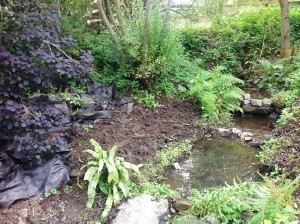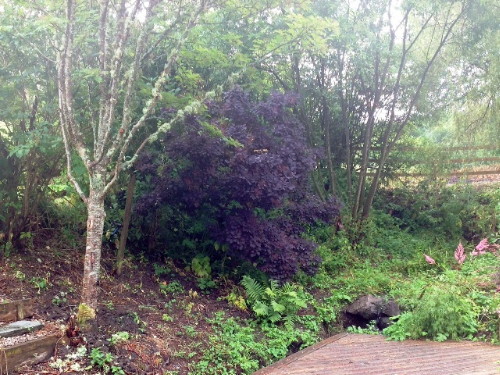Planting native bulbs within a woodland setting……

I am trying to readjust the balance of ground cover in a small woodland setting within a garden by planting native species that I have seen growing locally, English bluebells, wood anemone and wild garlic. It is late Autumn and the ground is currently covered in brambles, bindweed, nettles, dock and other unwanted plants. It will be quite a job to clear it manually. I have already planted some ferns in the area, which seem to be thriving in the dappled light of the waterside setting and are shading out some unwanted plant growth but not much.
I have also cut back lots of the larger brambles and tall nettles at the edges of the area to let in more light. This should help with establishing new plants but may also encourage new weeds. I am hopeful but have no idea whether this will work well or whether it will be a thankless task. At the moment the nettles, brambles and hogweed are everywhere. The hope is that the new plants will create a carpet ground cover effect helping to suppress some of the unwanted weeds. I start to clear the area by digging out nettles, docks, bindweed and brambles then covering large areas in heavy weed membrane to weaken the existing plants. Ideally this whole area would be covered in old carpets or weed membrane for much longer to kill or weaken the weeds. It is not a suitable area for weed killing chemicals as there is a stream running right through the middle and the possibility is that the chemicals would drain into the water. The roots of all these plants explain why they are so successful - long stinging nettle roots running for metres under the soil collecting nutrients, and deep set bulbous hogweed refusing to budge. The giant hogweed can cause skin irritation and burns so it's a good idea to cover arms with long sleeves.
I have ordered bulbs and rhizomes from a website specialising in native plants. The package arrives with information explaining how the bulbs should be planted and the bulbs are separated into varieties with instructions to 'plant immediately'. The bluebell bulbs are tiny white teardrops, the wild garlic long and thin bulbs with thick,white spidery roots and the anemone rhizomes are tiny sticks between an inch and three inches long so no worry about confusing them. I soon worked out that preparing the ground was key to planting these bulbs. Digging over the ground to clear roots was no fun but left me with an easier job planting. The bluebell bulbs went in easily, pushed in with my finger in the soft ground. The wild garlic needed a wider planting hole for the wide roots, which I had to keep tucking back in. The anemone rhizomes I placed under an inch or so of soil horizontally. It was so much easier planting than preparing. There seemed a lot of bulbs in the packages - 100 bluebells, 100 garlic and 100 wood anemone but once planted there did not seem to be a huge amount of ground covered. Now all I need to do is keep the area as weed free as possible and wait for the spring to see what comes up. Fingers crossed!
Comments are closed for this post.
Discussion
We are in the process of buying a wood.There are lots of brambles in it. We are going to use a petrol brush cutter to clear some of the brambles to make pathways where we really need them, leaving islands of brambles for the wildlife and hopefully some berries for us.
On the rest we are intending to use markers where there are plants and young trees to keep throughout next year as they come up then plan some more clearance and replanting when we know whats there.
Stuart,
Do you know the history of the woodland in your garden? It sounds like it may have been recently established on a weedy site, hence the burgeoning of ruderal species, woody weeds. They will keep coming back so long as they get enough light and it will be a constant battle to defeat them. The only way to get rid of them permanently and establish a woodland flora, complete with spring bulbs, would be to establish a dense canopy of trees. But you may not wish to do this. Good luck. Fighting nature can be fun ! Donald
This is a wonderful project. I hope you will write again & post some photographs in the new season! I have been involved over the last couple of years in helping to establish a “bee-friendly” garden beside an old canal. We had much the same problems with weeds but gathered many “volunteers” to help remove them. The garden has worked well & the bees & other pollinators have had a great summer there.


I’m hoping to plant wild garlic bulbs on mass in a small woodland area, how many bulbs per square meter would everyone recommend.
Angela Harper
23 August, 2018